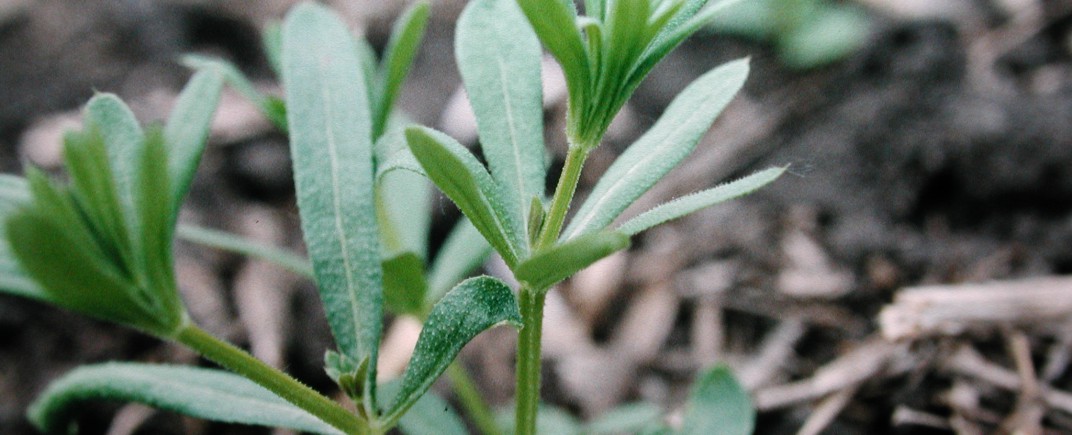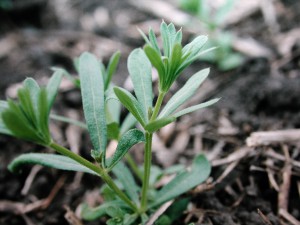Cleavers Galium aparine – Profile by Michelle Hildebrand
This plant is commonly known as a cleavers plant, and scientifically known as Galium aparine. The negative attributes of this plant are the seed size, and yield losses that they can cause with heavy infestations. The seed size is roughly the same as that of canola, and can be very difficult to separate at the time of harvest. Heavy infestations of this plant are known to cause yield losses in cereals, and as well flax crops. One known positive attribute of the plant is that it has been used for medicinal purposes. It has been used in traditional medicine for treating kidney problems, skin disorders, and high blood pressure.
Identification
Galium aparine is a climbing plant that attaches to surrounding hosts by its leaves, which are covered by hooked trichomes.
Leaves: The leaves are arranged in whorls of six, and are considered simple leaves. The edges of the leaf blade are entire, and the whole leaf is covered with hairs (trichomes) for attaching to other plants.
Flowers: The carpels of the flower are all fused to one another. The ovary is considered inferior, and does not always consist of a hypanthium. The flowers form a spiral around the inflorescence axis, consisting of four petals and sepals. http://www.floradecanarias.com/galium_aparine.html The petals are also fused into a corolla tube.
Fruit: When the fruit is ripe, it does not split open, but usually turns brown in colour. The fruit can range from 3-5mm in length, and has tiny hairs covering the fruit for a mode of transportation as the hairs catch easily to animal fur and clothing.
Stem: The hairs along the stem point downwards. The stem is very unique in the fact that a cross-section of a stem will roughly be a square in shape. The nodes are never swollen on this plant, and it http://www.fungoceva.it/erbe_ceb/galium_aparine.htm tends to grow in tufts and compact clusters. The stem is not very strong, which is why it is considered a climbing plant.
Adaptation
One very unusual adaptation found on the cleavers plant is the stem and its ability to still survive with breaking compared to other terrestrial species. The slight breaking of the stem allows the plant to better cope with sudden tugs like aquatic plants would if water flow rate were to change. The trichome mechanisms found all over the plant are the evolution of the plant to minimize wind effects by attaching to other objects for support.
Cultural Control
Control of cleavers can be difficult with the way the plant can grow. One cultural method that is used in organic agriculture is tillage. This method of control does have some drawbacks, as it is not a guaranteed method. With pre-seeding tillage, shallow tillage will encourage germination of cleavers seeds. A second tillage right before seeding should eliminate most seedlings. Fall tillage is best as it encourages seeds to germinate and the seedlings will be killed by frost.
Crop rotation that includes the incorporation of summer fallow, cereals, and perennial forages should help minimize cleavers populations. Winter annual cereals are very effective for this. Canola should not be grown on land with cleavers, as separation at harvest can be very difficult. Cereal crops also compete more vigorously with cleavers than oilseeds and pulses would. Rotations that are used to help eliminate cleavers should also avoid crop with no herbicide options, such as clover, lentils, and canola. Fields with heavy infestations should be planted with a perennial forage to reduce the population to a manageable level.
Summary
Cleavers tend to like moist, partially shaded areas. This plant has a very weak stem, which is why the plant has its name as it clings to other plants and surrounding objects for support. The small trichomes that cover the plant make the plant feel sticky when you run your finger along the stem. The seed capsules that emerge after the tiny flowers are like little green balls that can be easily transported by wind or biotic factors. The shape and size of the seed is roughly the same as a canola seed, which can make it incredibly difficult for separation at harvest.
It is an annual plant, but can overwinter, which means that re-growth for this plant is incredibly easy. In order to control this weed, it should never be grown in a canola rotation as there is little control that can be done with that crop. Deep cultivation is crucial
http://www.oardc.ohio-state.edu/seedid/single.asp?strId=343 for control as the deep burial of the surface seeds makes germination difficult for the plant. A competitive rotation of crops and soil management are of the best tools for controlling and managing the weed.
References
Barkley, Shelley. Revised 2010. Cleavers. Alberta Agriculture and Rural Development. Accessed January 16, 2014. http://www1.agric.gov.ab.ca/$department/deptdocs.nsf/all/prm2587
Bauer, Georg, M.C Klein, S.N. Gorb, T. Speck, D. Voigt, F. Gallenmuller. 2010. Always on the bright side: the climbing mechanism of Galium aparine. Proc. R. Soc. B. 278 (1715) 2233-2239. doi: 10.1098/rspb.2010.2038.
Galium aparine (cleavers). KEW Royal Botanic Gardens. Accessed January 7, 2014. http://www.kew.org/plants-fungi/Galium-aparine.htm
Galium aparine: Scratch bedstraw. 2013. Go Botany. NEWFS. Accessed January 14, 2014. https://gobotany.newenglandwild.org/species/galium/aparine/
Goodman, Adrian. 2004. Mechanical Adaptations of Cleavers (Galium aparine). Annals of Botany. 95 (3) 475-480. doi: 10.1093/aob/mci038.
Tilford, Gregory L.. 1998. From Earth to Herbalist: an earth-conscious guide to medicinal plants. Mountain Press. Missoula, Montana. 1-251.


